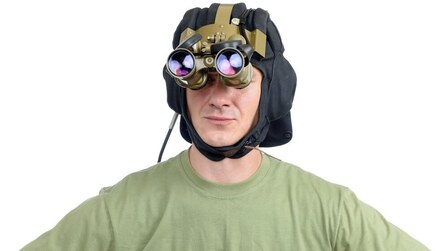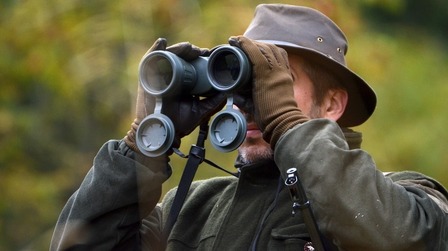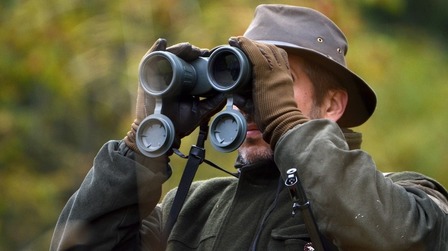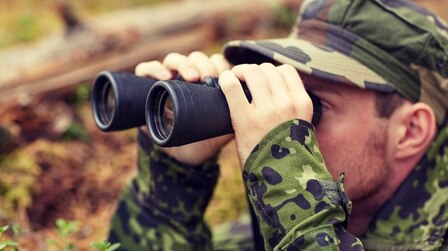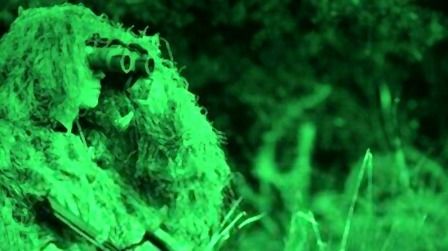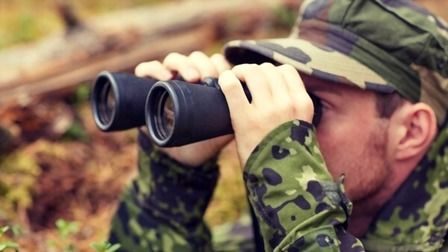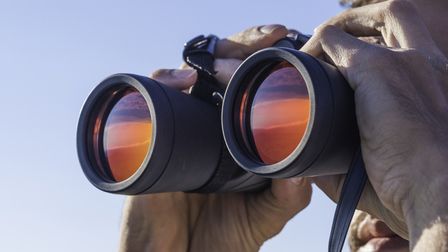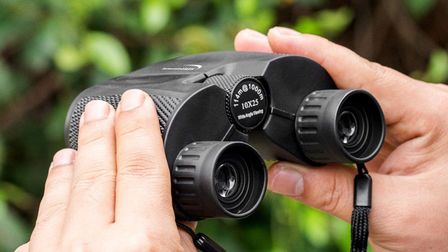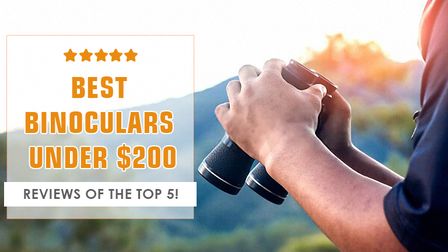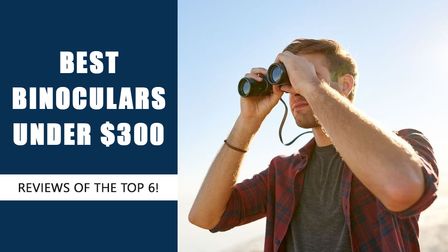There are myriad purposes that binoculars come into use. And for birdwatching, it must afford some specific requirements to give precise benefits to users.
Lightweightness is the first-and-foremost in this case. Read on to see our top pick items below.
Here are the best lightweight binoculars for bird watching (Jul 2025 Update):
- Best Overall: Vortex Optics Diamondback
- Top Rated: Vortex Optics Crossfire
- User Friendliest: Nikon 7576 MONARCH 5
- Best For Beginners: Celestron - Nature DX
- Best For Woods And Owls: Nikon 8245 ACULON A211
- Best For Extreme Weather: Wingspan Optics NaturePro
| Top 6 Best Lightweight Binoculars For Bird Watching | ||
|---|---|---|
Best Overall | Vortex Optics Diamondback | Read Our Review |
Top Rated | Vortex Optics Crossfire | Read Our Review |
User Friendliest | Nikon 7576 MONARCH 5 | Read Our Review |
Best For Beginners | Celestron - Nature DX | Read Our Review |
Best For Woods And Owls | Nikon 8245 ACULON A211 | Read Our Review |
Best For Extreme Weather | Wingspan Optics NaturePro | Read Our Review |
Best Overall: Vortex Optics Diamondback

Lightweight and compact to use
Fog-proofed to be used in early mornings or during cold, humid weather
Additional thumb indents for extra room to adjust the unit effortlessly
The diopter adjustment sometimes isn’t locked after adjustment
Deliver over richness of colors
One thing that really stood out during our test (compared to other counterparts) is lighting quality, especially in low light conditions. The image given is almost crisp, bright, and clear.
The whole unit is rather lightweight – 13.5 oz. – but doesn’t give any cheap feeling.
Give a gaze around it and you’ll see: Quality fully multi-coated lens, water and fog-proof features, and easy eyecups adjustment. They’re clearly improved, at least in terms of ergonomic feel.
In comparison to the previous versions, this is apparently more effective, implying that it is a bang for bucks.
Vortex Optics Diamondback Specifications | |
Magnification | 10x |
Field of View (degrees) | 5.25 |
Field of View (feet @ 1000yds) | 273 |
Prism | Proof |
Eye Relief (mm) | 16.0 |
Weight | 13.5 oz. |
Highlight Features | Argon purging and rubber armor Sleek Short hinge design with rubber armor and thumb indents |
With great improvements in image brightness, weight, and ergonomic feel, Vortex Optics Diamondback is the best-overall binocular that we’ve tried.
Top Rated: Vortex Optics Crossfire

Give steadier image even though it’s a 10x binocular
Offer superior clarity in different low light conditions
Affordable
Not fog-proofed
Priced a mere $50 cheaper, is the Vortex Optics Crossfire with not huge differences from the previous sibling. It’s therefore a good choice for people with tighter budgets.
Compared to other brands, such as Leupold and Bushnell, you’ll marvel at how stable image it delivers and its phenomenal clarity. From our tests, the unit works best at dusk, mid-day light, and bright light.
The design, on the other hand, is rather well-balanced to easily hold. While tracking birds, you can easily adjust its focus wheel and for eye relief.
Pretty ideal for an observing distance of 400 – 550 yards when regarding larger games. Importantly, it doesn’t flatten your wallet.
Vortex Optics Crossfire Specifications | |
Magnification | 10x |
Field of View (degrees) | 6.2 |
Field of View (feet @ 1000yds) | 325 |
Prism | Roof |
Eye Relief (mm) | 15 |
Weight | 23.3 oz. |
Highlight Features | Fully multi-coated lenses Twist-up eyecups A smooth center focus wheel And right eye diopter |
At a more affordable price, Vortex Optics Crossfire is worth trying for people with a tight budget.
User Friendliest: Nikon 7576 MONARCH 5

Show good color of birds and ambience
Equipped with many user-friendly features -> good for the low-tech
Focuses quickly for fast viewing
100% waterproof, fog proof, and shockproof
Close focus isn’t much perfect
Lens covers don’t fit nicely to the unit
Out of two options that the Nikon 7576 MONARCH 5 offers, we found the 8x42 to be better for birdwatching in terms of both image quality and clarity.
With a mere 5.5 degrees’ field of view, you can spot, observe, and follow birds a few feed ways out in the woods.
The size is perfect for travelers – big enough for suffice magnification and a nice hand-feel whereas small enough to carry along with no burden. The rubber coating is an additional compliment – it gives a good grip that you’ll never slip out the binocular outboard.
Nikon 7576 MONARCH 5 Specifications | |
Magnification | 8x |
Field of View (degrees) | 5.5 |
Field of View (feet @ 1000yds) | 288 |
Prism | Porro |
Eye Relief (mm) | 19 |
Weight | 1.3 pounds |
Highlight Features | Turn and Slide Rubber Eyecups A Smooth Central Focus Knob and Flip Down Lens Caps |
Built with many user-friendly features, such as Flip Down Lens Caps and Turn and Slide Rubber Eyecups, the Nikon 7576 is the best bet for low-tech bird watchers to start with.
Best For Beginners: Celestron - Nature DX

Eyeglass-friendly design
Durable enough to survive all manners of harsh weather
Give extra-wide field of view to observe birds better
Excellent performance in low light condition
No neck strap included
The reason why this binocular is voted for amateur birders is lower power.
One basic rule of thumb is – the stronger the magnification, the narrower the field of view. While birds tend to flint around, a lower-power 8x42 binocular like Nature DX will be better for you to easily let them in view without moving the bino around too much.
Not to say this delivers higher lighting condition.
We also appreciate its eyeglass-friendly design. With 17.5 mm of eye relief, you can use this unit with comfort while wearing eyeglasses.
Celestron - Nature DX Specifications | |
Magnification | 8x |
Field of View (degrees) | 7.4° |
Field of View (feet @ 1000yds) | 388 |
Prism | Phase Coated BaK-4 |
Eye Relief (mm) | 17.5 |
Weight | 1.75 pounds |
Highlight Features | Fully multi-coated optics and BaK-4 prisms Lightweight Eyeglass friendly |
With the perfect combination of close focus distance, field of view, and magnification, the Celestron Nature DX is highly recommended for beginners.
Best For Woods And Owls: Nikon 8245 ACULON A211

Give a flat field of view and enhance image clarity for clearer images in any low light conditions
Good field of view and magnification for easy birdwatching
Excellent ergonomics to easily carry along in woody areas
A bit big for people who love the trim look
What makes Nikon 8245 ACULON A211 become the best candidate for birdwatching in woody areas is its Aspherical Multicoated Eco-Glass Lenses.
This is a triad of optical technology taking the role of enhancing image clarity while giving a flat field of view. In other words, it assures sharper images in any low light conditions.
The weight is ideally light for people who walk a lot through praises and woods for birdwatching.
We also like the big improvement in neck strap, caps, and shell to be more comfortable and durable to use.
Nikon 8245 ACULON A211 Specifications | |
Magnification | 8x |
Field of View (degrees) | 8 |
Field of View (feet @ 1000yds) | 420 |
Prism | Porro |
Eye Relief (mm) | 12 |
Weight | 26.6 |
Highlight Features | Made with Aspherical Multicoated Eco-Glass Lenses bright and clear images in most lighting conditions |
For weight consideration and birdwatching in wooded areas, the Nikon 8245 might be what you’re after.
Best For Extreme Weather: Wingspan Optics NaturePro

Waterproof, drop-proof, fog-proof, and anti-slip coating to hold up well in any situations
Close focus to capture images in whichever distance ranges you want
Give true colors
A bit heavier than an 8x42 binocular supposed to be
Last but not least is the Wingspan Optics NaturePro. It’s a newcomer though, which is the reason you won’t see it popular on other birding sites.
What we love the most in this unit is its ultra-sturdy and durable construction with so many high-end features. Such as fog-proof, waterproof, anti-slip coating, and drop-proof features – things that any birders in inclement weathers always look for.
The price is amazingly affordable – under @120, with a bonus of the Extra-Wide Field of View to give you the best of both worlds.
Wingspan Optics NaturePro Specifications | |
Magnification | 8x |
Field of View (degrees) | 8.3 |
Field of View (feet @ 1000yds) | 430 |
Prism | Roof |
Eye Relief (mm) | 17.2 |
Weight | 1.5 pounds |
Highlight Features | Waterproof Fog-proof With an anti-slip grip for added protection |
If you’re looking for a monster binocular to handle well in harsh weathers, look no further than Wingspan Optics NaturePro
How To Choose A Best Lightweight Binoculars For Bird Watching?
Magnification
The stronger the magnification, the narrower the field of view.
For bird watching, don’t try to go for the highest indicators. Not only because of its unsteady image delivers but higher magnifications are also hard to spot a bird and follow it. With a block of birds, a lower power will allow you to see more.
Most bird-watchers choose to bring a 7x, 8x or 10x binocular home.
If any goes higher than that, the device must be high-quality to ensure the image isn’t shaking. And you should have a sturdy tripod and spotting scopes.
Objective Lens
The bigger the lens, the brighter the image but meanwhile, the heavier and bulkier the binoculars. That’s the reason I don’t highly recommend selecting the biggest lens.
Such monster binoculars (with extremely large lens) are just suitable for people who just sit on their backyard lounger and watch the bird. With travelers or backpackers, 30mm to 50mm is an ideal range of objective lens diameter, for the sake of portability and price.
Ease of focusing
As birds love moving from here to there, you should choose a binocular that can focus quickly.
A fine focus mechanism, in this case, is rather important. It lowers the number of knob turning just to bring birds into focus, implying less disruption for your birdwatching moments.
My recommendation is a binocular featuring central focus because you can effortlessly turn it with your finger index
Which Brands Make The Best Lightweight Binoculars For Bird Watching?
Vortex Optics
Established in 2004, Vortex Optics is now a well-known American manufacturer specialized in optics equipment and device. Their binocular lines are not only well-loved by guaranteed quality and lightness but also the versatilities that hardly other brands can follow.
Nikon
Nikon is an OG in worldwide optics equipment industry. Based in Tokyo, Japan, it’s currently one of the biggest multinational corporation whose products have received countless good feedbacks from customers for phenomenal performance and furthermore, user-friendly designs.
Celestron
Another America-based brand is Celestron, founded in 1955. They’re famous for optics equipment such as spotting scopes, riflescopes, and binoculars.
Wingspan
Wingspan is the youngest out of four brands but they’re specialized the most in birdwatching. That makes their product lines – which are monocular and binoculars – afford precisely the needs of bird watchers.
FAQs
Can binoculars hurt eyes?
It depends on two things:
- What’re you trying to observe when using it
- How often do you use it
If you try to look at the sun through it, surely there are more or less damage to your eyes. Frequent usage also leaves some side effects on the eyes but it’s not so much.
Are binoculars better than a telescope?
In some aspects, using a binocular is better than a telescope:
Binoculars give wider field of view to let users (especially beginners) quickly get familiar with how to spot and follow constant moving subjects. Besides, it collects better light than a telescope so that you can get a better, general view.
Using binoculars force you to learn more about the things you want to observe, like stargazing. The more you use it, the less dependent you’re in relevant systems.
Are the binoculars with the highest magnification the best?
Not at all. Binoculars with the highest magnification have their own weakness:
- More shaking image
- Lower brightness on the image
- Hard to follow a constantly moving thing, like birds
Can I use birding binoculars with glasses?
Yes, you can.
A binocular with extra-long eye relief (usually within 17mm to 20mm) will deliver reasonable distance so that you can use it with comfort.
How do you use bird watching binoculars?
Using a binocular for birdwatching doesn’t require any professional techniques. Once seeing a bird, slowly raise the binocular and use your finger to adjust the focus wheels until you can see them clearly.
Ensure the field of view is wide enough so that you can see and follow their movements easily.
How do I clean my birding binoculars?
The whole cleaning process is divided into three steps:
- Get rid of loose dust from its lenses by rubbing gently a specialized lens cleaning pen. Or use a blower to blow air into. Don’t use your breath.
- Use lens cleaning solutions or just clean water to wet the Q-tip, remove stubborn dust and stains
- Wipe dry the whole binoculars.
Conclusion
That’s all for this article. It’s your turn now!
Be sure to identify your purposes when choosing the best binocular for bird watching, everything will be easier. Thanks for reading!


